Original: Macintosh[edit]

The original platform that the game was designed for an programmed on. ICOM's intention was to take a traditional text adventure game, and evolve it into a more visually interactive system. It runs in a relatively high resolution 512x320 window and is completely integrated with the system interface, using the same dialogue dialogue boxes and fonts. Due to the nature of the system, the visuals are entirely in black and white.
Computer ports[edit]
Apple IIGS[edit]
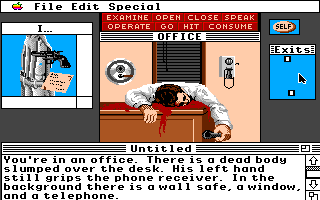
Though marketed as part of the Apple II family, the IIGS had a fully 16-bit processor (the same one used in the Super Nintendo) and as such, was capable of a relatively impressive conversion of the game. Though it decreases in resolution from the Macintosh, it gains the ability to display the visuals in full color.
Atari ST[edit]
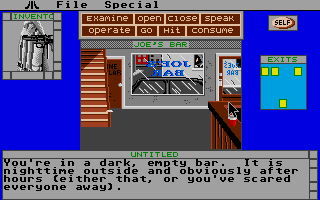
The 16-bit Atari computer conversion is extremely comparable to the Apple IIGS conversion, down to visual capability and user interface.
Commodore Amiga[edit]
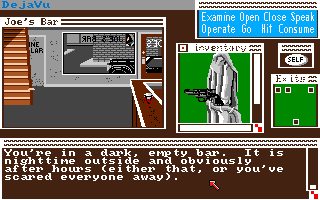
While many Atari ST and Commodore Amiga games were extremely similar and difficult to tell apart, the Amiga conversion of Déjà Vu contains slightly improved artwork and a tweaked user interface
Commodore 64[edit]
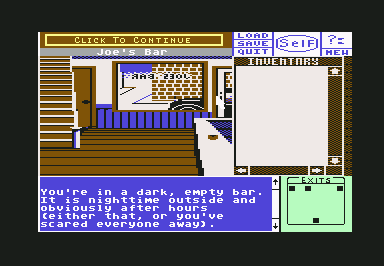
The Commodore 64 version is perhaps the most compromised out of all the computer conversions. The cursor is controlled with a joystick instead of a mouse, since mice were not common at the height of the C64's popularity. Scenes constantly load from disk making moving from location to location a bit slow. The graphics are cruder and number of simultaneous colors are reduced, but other than that, the core gameplay is present.
DOS[edit]
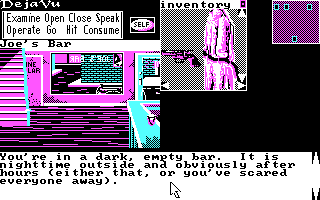
Although as potentially capable as the Atari ST or Commodore Amiga versions, the restriction of four color CGA graphics makes this version one of the less attractive to look at. It also does not allow you to resize or move the windows.
Microsoft Windows 3.1[edit]

This early Windows release was part of a compilation of both Déjà Vu titles featuring redrawn and enhanced graphics, and is completely integrated into the Windows interface, like the original Macintosh version. It also features a more organized windows system (such as the ability to automatically organize the inventory). This version was used as the basis for the PocketPC version, released in 2002.
NEC PC-98[edit]

This version was ported and published in Japan by Pack-In Video, and is similar to the Amiga version, although the graphics have been reduced to 16 colors.
Console ports[edit]
NES[edit]
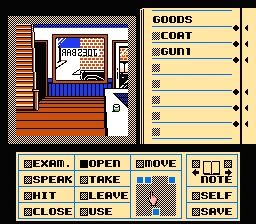
This conversion differs substantially from the original version in many ways. The basic storyline, locations, text and puzzles are the same, but all have had slight tweaks. The 16-color graphic windows are completely unique, although similar in style to the Amiga version. Background music has bee introduced throughout the game. A warping effect, complete with sound effects, is used to transition between rooms. The text is displayed as if it were typed by a typewriter. The interface has been altered to remove the drag and drop inventory system, instead adding "Take" and "Leave" verbs, and getting rid of the "Consume" action. (You instead just "Use" items on yourself.) Your inventory now shows up as text on the right side of the screen rather than visual icons. The "Leave" action is almost entirely useless since you can only drop items in a specific place instead of leaving them randomly strewn around, but since you have unlimited inventory space in this version, this is never an issue. While you can still save your game at any time, getting killed will simply rewind time and send you back to the prior screen, so there's no need to constantly save your game.
On the downside, navigation is a pain. Moving the cursor with the controller is sluggish compared to the mouse. Furthermore, the computer versions let you open doors, look at items, or move simply by double clicking on the screen. The NES interface is not context sensitive at all, so you need to select from the verb window for every single action, which slows the game down.
The computer versions had several instances where you needed to discover and remember addresses to give to taxi drivers, which needed to be typed in. Since the NES does not have a keyboard, these have been simplified into an "Address" page in your inventory, which are automatically recorded when you learn them. While much of the text maintains the same flavor as the PC version, the writing had to be simplified and edited to save ROM space. It also falls victim to Nintendo's censorship policies. Instead of a shot-glass of gin and a pack of cigarettes, you'll find a glass of seltzer and a pack of chewing gum. Instead of a syringe to administer drugs, you need to use medicine capsules.
Some scenes have been taken out too. After you beat up the hooker, if you try to hit her again when she's down, you get a flashback of your priest warning you not to do terrible things. In the NES version, it just displays a general "you can't do that" message. The NES version also never explicitly refers to her as a hooker; she's just some random lady. When you die in the computer versions, it's a either shot a morgue, with a close-up on your toe tag, or pictures of creepy ghosts. This was perhaps a bit too morbid, so it was changed to a tombstone with an "RIP Ace Harding" message on it. The death text is also unique: "From the beginning the odds were against you. It was only a matter of time until you reached the end. You're history!!" Certain actions are required to proceed in order to force the plot; you can't even leave the bathroom in the beginning until you've looked in the mirror first.
Game Boy Color[edit]
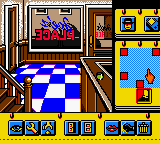
Deja Vu was re-released several years later for the Game Boy Color, where it was bundled with its sequel. It's similar to the Game Boy port of Shadowgate, although the interface has been slightly altered to use icons for the commands instead of text, saving valuable screen real estate. The visuals appear to be completely new and improved. The music is mostly the same as the NES version. The text is almost entirely identical, and the bar is now referred to as "Joe's Place" rather than "Joe's Bar".